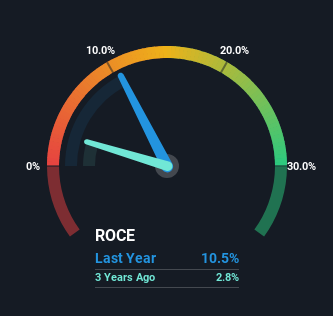Be Wary Of Inner Mongolia Yuan Xing Energy (SZSE:000683) And Its Returns On Capital
If you're looking for a multi-bagger, there's a few things to keep an eye out for. Firstly, we'll want to see a proven return on capital employed (ROCE) that is increasing, and secondly, an expanding base of capital employed. Ultimately, this demonstrates that it's a business that is reinvesting profits at increasing rates of return. Having said that, from a first glance at Inner Mongolia Yuan Xing Energy (SZSE:000683) we aren't jumping out of our chairs at how returns are trending, but let's have a deeper look.
Return On Capital Employed (ROCE): What Is It?
Just to clarify if you're unsure, ROCE is a metric for evaluating how much pre-tax income (in percentage terms) a company earns on the capital invested in its business. To calculate this metric for Inner Mongolia Yuan Xing Energy, this is the formula:
Return on Capital Employed = Earnings Before Interest and Tax (EBIT) ÷ (Total Assets - Current Liabilities)
0.10 = CN¥2.5b ÷ (CN¥33b - CN¥9.1b) (Based on the trailing twelve months to September 2023).
So, Inner Mongolia Yuan Xing Energy has an ROCE of 10%. In absolute terms, that's a satisfactory return, but compared to the Chemicals industry average of 5.7% it's much better.
See our latest analysis for Inner Mongolia Yuan Xing Energy

Above you can see how the current ROCE for Inner Mongolia Yuan Xing Energy compares to its prior returns on capital, but there's only so much you can tell from the past. If you'd like, you can check out the forecasts from the analysts covering Inner Mongolia Yuan Xing Energy for free.
What Does the ROCE Trend For Inner Mongolia Yuan Xing Energy Tell Us?
In terms of Inner Mongolia Yuan Xing Energy's historical ROCE movements, the trend isn't fantastic. Around five years ago the returns on capital were 17%, but since then they've fallen to 10%. However it looks like Inner Mongolia Yuan Xing Energy might be reinvesting for long term growth because while capital employed has increased, the company's sales haven't changed much in the last 12 months. It's worth keeping an eye on the company's earnings from here on to see if these investments do end up contributing to the bottom line.
On a related note, Inner Mongolia Yuan Xing Energy has decreased its current liabilities to 27% of total assets. So we could link some of this to the decrease in ROCE. Effectively this means their suppliers or short-term creditors are funding less of the business, which reduces some elements of risk. Some would claim this reduces the business' efficiency at generating ROCE since it is now funding more of the operations with its own money.
The Bottom Line On Inner Mongolia Yuan Xing Energy's ROCE
Bringing it all together, while we're somewhat encouraged by Inner Mongolia Yuan Xing Energy's reinvestment in its own business, we're aware that returns are shrinking. Yet to long term shareholders the stock has gifted them an incredible 107% return in the last five years, so the market appears to be rosy about its future. Ultimately, if the underlying trends persist, we wouldn't hold our breath on it being a multi-bagger going forward.
On a final note, we've found 3 warning signs for Inner Mongolia Yuan Xing Energy that we think you should be aware of.
While Inner Mongolia Yuan Xing Energy may not currently earn the highest returns, we've compiled a list of companies that currently earn more than 25% return on equity. Check out this free list here.
New: AI Stock Screener & Alerts
Our new AI Stock Screener scans the market every day to uncover opportunities.
• Dividend Powerhouses (3%+ Yield)
• Undervalued Small Caps with Insider Buying
• High growth Tech and AI Companies
Or build your own from over 50 metrics.
Have feedback on this article? Concerned about the content? Get in touch with us directly. Alternatively, email editorial-team (at) simplywallst.com.
This article by Simply Wall St is general in nature. We provide commentary based on historical data and analyst forecasts only using an unbiased methodology and our articles are not intended to be financial advice. It does not constitute a recommendation to buy or sell any stock, and does not take account of your objectives, or your financial situation. We aim to bring you long-term focused analysis driven by fundamental data. Note that our analysis may not factor in the latest price-sensitive company announcements or qualitative material. Simply Wall St has no position in any stocks mentioned.
About SZSE:000683
Inner Mongolia Berun Chemical
Engages in the soda ash, methanol, fertilizer and agricultural production materials, and other businesses in China.
Undervalued with reasonable growth potential and pays a dividend.
Market Insights
Community Narratives



